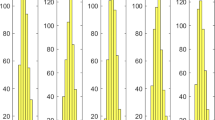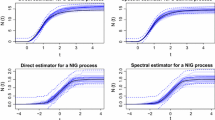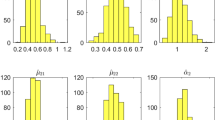Abstract
We address the issue of the local asymptotic normality property and the Fisher information for three characterizing parameters of Ornstein–Uhlenbeck processes with jumps under low frequency and high frequency discrete sampling with expanding observation window. The martingale method with the Kolmogorov backward equation and the Malliavin calculus are employed to derive explicit formulas for derivatives of the likelihood ratio function in the form of conditional expectation, which serve as essential tools for justifying the passage to the limit by the dominated convergence theorem. This approach makes it possible to carry out the proof without specifying the law of the jump component and without knowing the tail behaviors of the transition probability density and, as a consequence, to keep various types of jump structure within the scope of this article. The Fisher information under high-frequency sampling is essentially identical to the one for purely Gaussian Ornstein–Uhlenbeck processes due to the dominance of the Gaussian component over the jump component in the short time framework.
Similar content being viewed by others
References
Aït-Sahalia, Y., Jacod, J.: Fisher information for discretely sampled Lévy processes. Econometrica 76(4), 727–761 (2008)
Aït-Sahalia, Y., Jacod, J.: Is Brownian motion necessary to model high frequency data? Ann. Stat. 38(5), 3093–3128 (2010)
Barndorff-Nielsen, O.E., Shephard, N.: Non-Gaussian Ornstein–Uhlenbeck-based models and some of their uses in financial economics. J. R. Stat. Soc. Ser. B 63(2), 167–241 (2001)
Chandrasekhar, S.: Stochastic problems in physics and astronomy. Rev. Mod. Phys. 15(1), 1–89 (1943)
Dacunha-Castelle, D., Florens-Zmirou, D.: Estimation of the coefficient of a diffusion from discrete observations. Stochastics 19(4), 263–284 (1986)
Elworthy, K.D., Li, X.M.: Formulae for the derivatives of heat semigroups. J. Funct. Anal. 125(1), 252–286 (1994)
Gikhman, I.I., Skorokhod, A.V.: Stochastic Differential Equations. Springer, New York (1972)
Gobet, E.: Local asymptotic mixed normality property for elliptic diffusion: a Malliavin calculus approach. Bernoulli 7(6), 899–912 (2001)
Gobet, E.: LAN property for ergodic diffusions with discrete observations. Probab. Stat. 38(5), 711–737 (2002)
Gringorten, I.I.: Estimating finite time maxima and minima of a stationary Gaussian Ornstein–Uhlenbeck process by Monte Carlo simulation. J. Am. Stat. Assoc. 63, 1517–1521 (1968)
Jacod, J.: Inference for stochastic processes. In: Aït-Sahalia, Y., Hansen, L.P. (eds.) Handbook of Financial Econometrics: Applications. North-Holland, Amsterdam (2009)
Jongbloed, G., van der Meulen, F.H., van der Vaart, A.W.: Nonparametric inference for Lévy-driven Ornstein–Uhlenbeck processes. Bernoulli 11(5), 759–791 (2005)
Kallenberg, O.: Foundations of Modern Probability, 2nd edn. Springer, New York (2001)
Kawai, R.: Sensitivity analysis and density estimation on the Hobson-Rogers stochastic volatility model. Int. J. Theor. Appl. Financ. 12(3), 283–295 (2009)
Kawai, R.: On singularity of Fisher information matrix for stochastic processes under high frequency sampling. In: Cangiani, A. et al. (eds.) Numerical Mathematics and Advanced Applications. Springer (2011). ISBN 978-3-642-33133-6. http://www.springer.com/mathematics/computational+science+%26+engineering/book/978-3-642-33133-6
Kawai, R.: On the likelihood function of small time variance gamma Lévy processes. J. Stat. Plan. Infer. (2012) (under review)
Kawai, R., Kohatsu-Higa, A.: Computation of Greeks and multidimensional density estimation for asset price models with time-changed Brownian motion. Appl. Math. Financ. 17(4), 301–321 (2010)
Kawai, R., Masuda, H.: Local asymptotic normality for Meixner Lévy processes under high-frequency sampling. Stat. Probab. Lett. 81(4), 460–469 (2011)
Kawai, R., Masuda, H.: Exact discrete sampling of finite variation tempered stable Ornstein–Uhlenbeck processes. Monte Carlo Methods Appl. 17(3), 279–300 (2011)
Kawai, R., Masuda, H.: Local asymptotic normality for normal inverse Gaussian Lévy processes with high-frequency sampling, ESAIM. Probab. Stat. (2012). doi:10.1051/ps/2011101
Kawai, R., Masuda, H.: Infinite variation tempered stable Ornstein–Uhlenbeck processes with discrete observations. Commun. Stat. Simul. Comput. 41(1), 125–139 (2012)
Le Cam, L., Yang, G.: Asymptotics in Statistics: Some Basic Concepts, 2nd edn. Springer, New York (2000)
Long, H.: Least squares estimator for discretely observed Ornstein–Uhlenbeck processes with small Lévy noises. Stat. Probab. Lett. 79(19), 2076–2085 (2009)
Luschgy, H.: Local asymptotic mixed normality for semimartingale experiments. Probab. Theor. Relat Fields 92(2), 151–176 (1992)
Masuda, H.: Joint estimation of discretely observed stable Lévy processes with symmetric Lévy density. J. Jpn. Stat. Soc. 39(1), 49–75 (2009)
Neumann, N.H., Reiß, M.: Nonparametric estimation for Lévy processes from low-frequency observations. Bernoulli 15(1), 223–248 (2009)
Nualart, D.: The Malliavin Calculus and Related Topics, 2nd edn. Springer, Berlin (2006)
Rosiński, J.: Tempering stable processes. Stoch. Process. Appl. 117(6), 677–707 (2007)
Roussas, G.G.: Contiguity of Probability Measures: Some Applications in Statistics. Cambridge University Press, London (1972)
Sato, K.: Lévy Processes and Infinitely Divisible Distributions. Cambridge University Press, Cambridge (1999)
Strasser, H.: Mathematical Theory of Statistics. Statistical Experiments and Asymptotic Decision Theory. Walter de Gruyter& Co., Berlin (1985)
Szimayer, A., Maller, R.: Testing for mean reversion in processes of Ornstein–Uhlenbeck type. Stat. Inference Stoch. Process. 7(2), 95–113 (2004)
Tuckwell, H.: A study of some diffusion models of population growth. Theor. Popul. Biol. 5(3), 345–357 (1974)
Tuckwell, H.: Introduction to Theoretical Neurobiology, vol. 2: Nonlinear and Stochastic Theories. Cambridge University Press, Cambridge (1988)
Uhlenbeck, G.E., Ornstein, L.S.: On the theory of Brownian motion. Phys. Rev. 36(5), 823–841 (1930)
Vasicek, O.: An equilibrium characterisation of the term structure. J. Financ. Econ. 5(2), 177–188 (1977)
van der Vaart, A.W.: Asymptotic Statistics. Cambridge University Press, Cambridge (1998)
Woerner, J.: Local asymptotic normality for the scale parameter of stable processes. Stat. Probab. Lett. 63(1), 61–65 (2003)
Woerner, J.: Estimating the skewness in discretely observed Lévy processes. Econom. Theor. 20(5), 927–942 (2004)
Author information
Authors and Affiliations
Corresponding author
Additional information
This study was carried out largely while the author was based at University of Leicester, UK.
Appendix: Basic Facts on the Malliavin Calculus
Appendix: Basic Facts on the Malliavin Calculus
We here summarize basic facts on the Malliavin calculus on the Gaussian space in brief. (For details and more notations, we refer the reader to the monograph [27] and [17].) Fix \(T>0\) and we denote, as before, by \((\fancyscript{F}^1_t)_{t\in [0,T]}\) and \((\fancyscript{F}^2_t)_{t\in [0,T]}\) the filtrations generated respectively by \(\{W_t:\,t\in [0,T]\}\) and \(\{\mu ({\text{ d}}z,{\text{ d}}t):\,t\in [0,T],\,z\in \mathbb R _0\}\) in (2.1) and (4.3). Let \(F\) be a random vector in \(\mathbb R ^d\), measurable with respect to the union \(\fancyscript{F}^1_T\cup \fancyscript{F}^2_T\). We denote by \(D_{\cdot }\) the Gaussian Malliavin derivative, and denote by \(\delta \) the Gaussian Skorohod integral over \((0,T]\), that is, for a suitable smooth stochastic process \(\{G_t:t\ge 0\}\) in \(\mathbb R ^d\),
where the multivariate integral is taken componentwise. Both the operators \(D\) and \(\delta \) are linked by the equality
given the \(\sigma \)-field \(\fancyscript{F}_T^2\). Moreover, taking the conditional expectation, we get the duality;
Here, we have assumed that \(F\in \mathbb D ^{1,2}\) and \(G\in Dom(\delta )\).
We next give an integration by parts formula, in the one dimension framework for simplicity, which is a key tool to integrate the derivative in the following conditional expectation for \(g\in C^1_b(\mathbb R ;\mathbb R )\),
where \(X, Z\), and \(H\) are suitable random variables. By the chain rule of the Malliavin derivative, we have that given the \(\sigma \)-field \(\fancyscript{F}^2_T\) and for \(t\in [0,T]\),
where \(\{h_t:t\in [0,T]\}\) is a suitable “smooth” stochastic process such that the terms appearing below are well defined. Integration over \([0,T]\) leads to
Using the duality (5.1), we get
This identity is often called the (conditional) integration-by-parts formula.
Finally, we describe the transformation of the Skorohod integral \(\delta W_t\) to the standard Ito integral \({\text{ d}}W_t\) on the Gaussian space (that is, again with the jump component \(\{Z_t:\,t\in [0,T]\}\) frozen). In short, the transformation is carried out as either
or
for suitable deterministic functions \(f(t,s)\) and \(f(t,s,u)\). In our context, the integral \(\int _0^t (t-s)e^{-\lambda (t-s)}{\text{ d}}Z_s\) in the first component of \(\nabla _{\theta }X_t(\theta )\) is treated as a deterministic function in \(t\), as the Poisson component is independent of the Brownian component and is set to be frozen when performing the relevant operations. We refer the reader to Sect. 1.3 of Nualart [27] for details of this transformation.
Rights and permissions
About this article
Cite this article
Kawai, R. Local Asymptotic Normality Property for Ornstein–Uhlenbeck Processes with Jumps Under Discrete Sampling. J Theor Probab 26, 932–967 (2013). https://doi.org/10.1007/s10959-012-0455-y
Received:
Revised:
Published:
Issue Date:
DOI: https://doi.org/10.1007/s10959-012-0455-y




